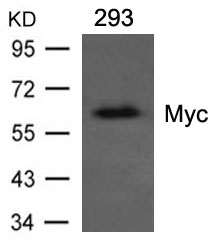Product Detail
Product NameMyc Mouse Monoclnal Antibody
Clone No.3.00E+08
Host SpeciesMouse
ClonalityMonoclonal
IsotypeIgG1
PurificationAntibodies were produced from mice ascites by injecting mice with a monoclonal cell line which was fusioned by mouse spleen and SP2/0 myeloma cell. Spleen cells were isolated from mice by immunizing with synthetic peptide and KLH conjugates.
ApplicationsWB
Species ReactivityHu
SpecificityThis mouse mAb only detects transfected proteins.
Immunogen TypePeptide-KLH
Immunogen DescPeptide sequence derived from C-terminal (aa. 410-432) of human c-Myc conjugated with KLH.
Target NameMyc
ConjugateUnconjugated
Other Namesc-myc
Accession NoSwiss-Prot: P01106
NCBI Protein: NP_002458.2
Uniprot
P01106
Gene ID
4609;
Concentration1.0mg/ml
FormulationSupplied in mice ascites.
StorageStore at 4°C for short term use. Store at -20°C for long term preservation. Avoid freezing and thawing repeatly.
Application Details
Predicted MW: 60kd
Western blotting: 1:500~1:1000
Western blot analysis of extracts from 293 cells transfected with recombinant human Myc using Myc mouse mAb #21390.
Myc proto-oncogene encodes nuclear DNA-binding phosphoproteins that are involved in the regulation of gene expression and DNA replication during cell growth and differentiation. Myc encodes a protein of 65 kDa which is expressed in almost all normal and transformed cells. The expression correlates with the proliferation state of the cells. Transcription is repressed in quiescent or terminally differentiated cells. Expression of Myc is generally induced after mitogenic stimulation of cells or serum induction. Myc therefore is an important positive regulator of cell growth and proliferation. Myc has been demonstrated also to be a potent inducer of apoptosis when expressed in the absence of serum or growth factors. Apoptosis may serve also as a protective mechanism to prevent tumorigenicity elicited by deregulated Myc expression. Sequences of the Myc oncogene have been highly conserved throughout evolution, from Drosophila to vertebrates
Baudino T A, et al. (2001) Mol Cell Biol. 21: 691-702.
Blackwood E M, et al. (1991) Science. 251:1211-1217.
Henriksson M, et al. (1996) Adv Cancer Res. 68: 109-182.
Grandori C, et al. (2000) Annu Rev Cell Dev Biol. 16: 653-699.
If you have published an article using product 21390, please notify us so that we can cite your literature.
et al,ERK1/2-dependent phosphorylation and nuclear translocation of PKM2 promotes the Warburg effect.In Nat Cell Biol on 2012 Dec by
Weiwei Yang, Yanhua Zheng,et al..PMID:23178880
, (2012),
PMID:
23178880
et al,Inhibition of DNA-PK enhances chemosensitivity of B-cell precursor acute lymphoblastic leukemia cells to doxorubicin.In Biomed Pharmacother on 2017 Oct by Fatemeh Alikarami , Majid Safa,et al..PMID: 28821159
, (2017),
PMID:
28821159



 Yes
Yes



